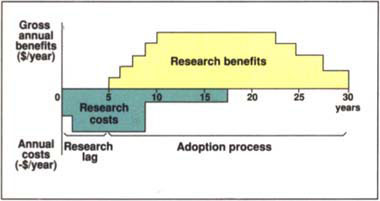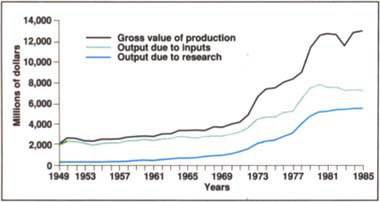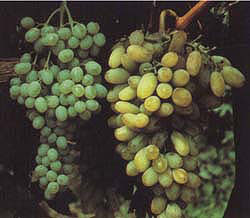All Issues
Research update: Economists calculate research payoff, effect of cuts
Publication Information
California Agriculture 48(3):5-6.
Published May 01, 1994
PDF | Citation | Permissions
Full text
Agricultural research and development is the chief reason California farm output increased nearly 3-fold from 1949 to 1985, while inputs rose only 1.6-fold, says a new report from UC's Agricultural Issues Center.
Valuing UC Agricultural Research and Extension documents the role of research in California's economic growth, but cautions that the decline in public funds for research since 1991 may put the state's vibrant agricultural economy at risk.
The authors estimate that the average annual return on publicly funded agricultural research is about 20%, which compares favorably to the rates at which government could invest.
“On that basis, this has been a good investment for society,” said Julian Alston, one of the study's authors. “However, this estimate is conservative compared with many studies indicating returns of 30 to 70% annually.”
To compute the rate of return, the economists first compared the stream of yearly research benefits from 1949 through 1985 with the stream of research expenditures from 1914 to 1985. Because the study did not account for research benefits before 1949 and after 1985, the result — a 21.4% average annual return — was conservatively low.
“However, previous estimates may have understated costs by not allowing for the full cost to society of using tax revenues, and by excluding some associated overhead costs such as basic research,” Alston said. “Also, benefits may have been overstated by disregarding effects of private research and government commodity programs.”
Because not all productivity growth can be attributed to public sector research, the authors then supposed that half of the measured benefit from research in every year was due to unmeasured factors such as private research and spill-in technology. They found the rate of return was reduced to 19.5 percent (when including research costs alone) and 17.1 percent (when using the sum of research and extension costs).
“The rate of return was quite insensitive to whether we cut the stream of benefits in half or included extension and research costs,” Alston said. “The explanation is that annual benefits are very large relative to costs and accrue over a relatively brief period of years. Annual costs are much lower and take place over many more years.”
In recent years, the annual flow of benefits from productivity growth since 1949 has been many times greater (about 50 times greater in 1985) than the annual flow of research costs, the authors observed.
“This fact alone would tend to support the view that agricultural R&D is a highly profitable investment,” Alston noted.
The report details research costs and payoffs to three leading California industries: dairy, wine and grape, and strawberry.
Dairy
California's top farm income producer is the dairy industry, contributing 14% of the state's agricultural output.
-
The state's milk production is worth $2.5 billion annually while UC dairy research costs, including the veterinary school, are about $5 million per year.
-
In 1991, the average California dairy cow produced 18,623 pounds of milk — 30% more than the 14,376-pound U.S. average excluding California.
-
UC researchers developed a technology, now in the patent stages, that removes the cholesterol from milk fat with no effect on taste.
-
UC Davis School of Veterinary Medicine developed a vaccine for E. coli mastitis. The vaccine saves California dairy operators an estimated $17.1 million annually in milk saved and also means less use of antibiotics.
Grapes and wine
-
Average grape yield doubled between 1930 and 1990, largely due to UC field research that led to advances in pest control, pruning, trellising, irrigation and other viticultural practices. Winegrape acreage statewide has doubled in the last 20 years. Today California produces more than 90% of the nation's wine.
-
UC enologists have improved wine quality through classification of yeasts, use of clarifying agents, control of wine spoilage bacteria, control of fermentation temperature, improvement of filtration and use of stabilizing agents.
-
UC scientists have devised simple tests to help grape growers determine optimal harvest time, published refrigeration and stabilization guidelines, demonstrated the effect of wood barrels on quality and flavor, and evaluated chemicals available to wineries.
Strawberries
-
In 1991 more than 88% of California's strawberry acreage was planted to UC-developed varieties. Since 1945, UC has released a succession of 40 strawberry varieties, all tailored to specific California growing conditions.
-
From 1956 to 1991, strawberry farm production value rose from $1.8 million to $493.3 million. Average yields rose from 3.1 tons to 26.8 tons per acre.
-
UC experiments with drip irrigation on strawberries began in the 1960s. Today, 100% of the acreage is drip irrigated.
—Editor
Valuing UC Agricultural Research and Extension, by Julian M. Alston, associate professor of agricultural economics, UC Davis; Philip G. Pardey, associate professor of agricultural and applied economics, University of Minnesota; and Harold O. Carter, professor emeritus of agricultural economics, UC Davis, may be ordered from the Agricultural Issues Center, UC Davis, Davis, CA 95616.







